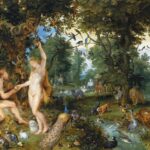
Wood (oak) 38 x 30.4 x 33.7 cm
Signed and dated on left of plinth: E Barlach 1919
Source: http:// http://www.moellerfineart.com/moeller-fine-art/notable-sales/ernst-barlach?view=slider

The figure of Ernst Barlach’s “Veiled Beggar Woman (Mercy)”, is unidentifiable. We can see some garments and arms firmly outstretched, patient, dignified and expectant. The beggar is further dignified through the use of the oak wood that is carved economically in blocky forms. But a cloth covering the head hides the identity, seemingly, of a woman. Being an artwork rather than a real person, we are unlikely to feel the need to rummage through our pockets for a coin or respond by walking on resolutely, rather, if we spend enough time with the sculpture, we may move from reaction to reflection.
Although appearing still, the beggar’s posture demands something of us. There is a clear material need that the figure is expressing, but not as an inferior being. An absence of identity inhibits our ability to judge and therefore to distance ourselves on the basis of identity. The cloth over the head is not due to shame, rather the anonymity draws attention to the figure being just like us. This is an equal who remains dignified, on the basis of its inherent sameness to us, on the basis of its right to ask and receive a response, because in a way, it is us.

Bronze (cast 1937) 35.4 x 38.4 x 14.1 cm
Ernst Barlach Haus Hamburg, acquired 1994
Source: https://www.barlach-haus.de/en/museum/collection/
“Refugee” also by Barlach, describes a figure thrusting forward in diagonal movement, cloaked heavily and protecting a loaf of bread. The face which is visible seems to push forward in hope with quiet determination, summing all available resources and human energy to move to a point where living is feasible. It is consumed by a lunge for life with all the life it has within it.
Neither the beggar nor the refugee use sentimentality. Neither try to draw pity from us. Key to both works is how the lines of the sculptures relate movement. For the beggar it is the motionlessness solidity seeking our response. The only movement is that of the extended arms, reaching out to us. The only thing this figure has, is us, the viewer and our response. The question then, is how do we respond? Any one of us could be beneath that cloth. A call is issued as we encounter ourselves in an other’s need, in what Emmanual Levinas called the ‘face to face’. We are really face to face with ourselves and we get to decide through our response, what is important and what we abandon. By comparison, the refugee is itself, all movement, caught mid step. Strong diagonal lines of the cloak show a driven figure as it escapes past us. There is no security or certainty in this moment and we watch as bystanders. The refugee unlike the beggar asks us not to break the movement, not to get in the way and interfere with its lunge to freedom. The call is upon us again, this time, not to needlessly hinder this lunge for life.
Words are approximate in their meaning. With language, some things fall through the gaps. However, this does not indicate that there is no reality beyond language, rather, our greatest values are established there. Powerful art gives access to that which lies beyond the limits of language, also beyond our political arguments and divisive maneuvering which are often based on language. Powerful art, even at its most figurative, never points to something. It points past it. That which is being represented is not, in almost all cases, meant to be taken on face value. Powerful art points to the in between of things, as with these works of a beggar and of a refugee where what is being described is the space between ourselves and self in the other. These works point us to where human vulnerability requires a response from us and our response establishes the value we place on human life.
Written by Marco Corsini.

